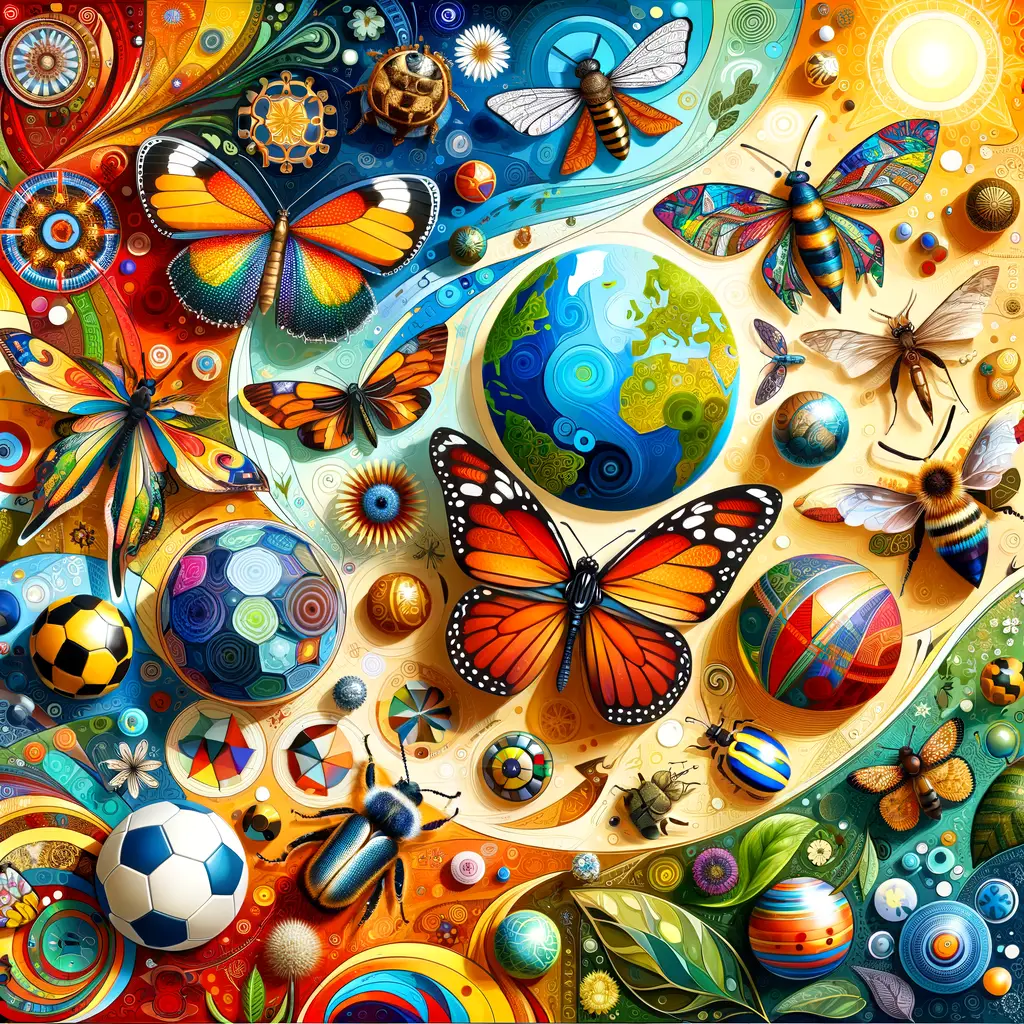
Introduction to Insects in Global Cultures
Insects, often overlooked by many, play a significant role in various cultures around the world. They are more than just tiny creatures; they are symbols, sources of inspiration, and even part of daily life in many societies. Let’s delve into the fascinating world of insects and their cultural importance.
- Overview of the cultural importance of insects
- Role of insects in different cultures
Insects have been part of human culture since ancient times. They are often associated with various symbols and meanings. For instance, in many cultures, butterflies symbolize transformation and change, while bees are seen as symbols of hard work and community. Some societies even incorporate insects into their diet, recognizing their nutritional value. Insects also play a crucial role in mythology, folklore, and art, showcasing their deep-rooted cultural significance.
Insects play different roles in various cultures. In some African cultures, termites and grasshoppers are considered a delicacy and are part of traditional meals. In Japan, the chirping of crickets is considered soothing and is often associated with the arrival of autumn. In Native American cultures, the spider is revered and often symbolizes creativity and weaving of destiny. These examples highlight the diverse roles that insects play in different cultures, from being a source of food to symbolizing various concepts and ideas.
Understanding the cultural importance of insects gives us a broader perspective on these tiny creatures. They are not just pests or nuisances but are integral parts of our world, contributing to our cultures in various ways. Stay tuned as we delve deeper into the cultural perspectives on insects, their significance worldwide, and their impact on different cultures.
The Cultural Perspective on Insects
Insects, small as they may be, hold a significant place in various cultures around the world. They are not just creatures that crawl or fly; they are symbols of different beliefs and traditions. Let’s delve into the cultural perspective on insects and understand their significance in different cultures.
The Significance of Insects in Different Cultures
Insects are seen differently across the globe. In some cultures, they are considered sacred, while in others, they are seen as symbols of good luck. Let’s explore how insects are viewed in Asian, African, and European cultures.
- Insects in Asian cultures
- Insects in African cultures
- Insects in European cultures
In many Asian cultures, insects, particularly butterflies and dragonflies, are seen as symbols of change and transformation. For instance, in Japan, the butterfly is often associated with the soul of the living and the dead. The Chinese, on the other hand, view crickets as symbols of luck and prosperity. In fact, cricket fighting is a popular pastime in China, dating back to the Tang Dynasty. You can read more about it here.
In African cultures, insects play a crucial role in mythology and folklore. The dung beetle, for example, is revered in ancient Egyptian culture as a symbol of the sun god, Khepri, who was believed to renew the sun every day. In West African folklore, the spider, known as Anansi, is a popular character in many tales and is considered a symbol of wisdom and storytelling. More about Anansi can be found here.
In European cultures, insects have diverse interpretations. In Ireland, for example, butterflies are believed to carry the souls of the dead to the afterlife. In Greek mythology, ants were transformed into humans to populate the earth, reflecting the industrious nature of this insect. The bee, on the other hand, is often associated with diligence and orderliness in many European cultures. Learn more about the symbolism of bees here.
From these examples, it is clear that insects are not merely pests or nuisances. They hold a deep cultural significance that is often overlooked. So, the next time you see an insect, remember that it could be a symbol of luck, transformation, or wisdom in another part of the world.
Insect Culture Worldwide: A Closer Look
Insects are not only fascinating creatures, but they also play a significant role in various cultures around the world. Let’s take a closer look at how insects are perceived and utilized in different societies.
World Cultures and Insects: Case Studies
Here are three case studies that highlight the importance of insects in different cultures:
-
Case Study 1: The role of insects in Japanese culture
In Japan, insects have a special place in culture and tradition. For instance, the Japanese rhinoceros beetle is a popular pet for children. In addition, the sound of crickets is often associated with the peacefulness of autumn nights. Insects also feature prominently in Japanese literature and art, symbolizing various aspects of life and nature.
-
Case Study 2: The significance of insects in Native American traditions
In Native American traditions, insects are often seen as symbols of transformation and change. The Monarch butterfly, for example, is considered a symbol of rebirth and regeneration. Insects also play a crucial role in their storytelling and mythology, teaching important life lessons.
-
Case Study 3: Insects in Australian Aboriginal culture
In Australian Aboriginal culture, insects are deeply respected for their ability to survive in harsh conditions. They are often used in Dreamtime stories to teach about survival, adaptation, and the importance of respecting the natural world. For instance, the honey ant is revered for its ability to store food for lean times, symbolizing preparation and foresight.
These case studies illustrate the diverse ways in which insects are valued and respected in different cultures. They remind us of the interconnectedness of all life forms and the importance of insects in our world.
Understanding the Global Insect Significance
Insects are not just tiny creatures that buzz around our homes and gardens. They play a significant role in our global ecosystem and economy, and hold symbolic meaning in various cultures. Let’s delve into these key takeaways to understand the global significance of insects.
- Key Takeaway 1: The Ecological Importance of Insects
- Key Takeaway 2: The Economic Impact of Insects
- Key Takeaway 3: The Symbolic Meaning of Insects in Various Cultures
Insects play a crucial role in maintaining the balance of our ecosystem. They are vital for pollination, a process that helps plants reproduce. Without insects, our food supply would be severely impacted as many crops rely on insects for pollination. Insects also contribute to nutrient cycling by breaking down dead plants and animals, turning them into nutrient-rich soil. According to a Wikipedia article, insects also serve as a food source for many animals, highlighting their importance in the food chain.
Insects have a significant economic impact. They contribute to agriculture by pollinating crops, controlling pests, and improving soil quality. According to a Wikipedia article, the economic value of these ecosystem services is estimated to be billions of dollars annually. However, insects can also have a negative economic impact when they damage crops or spread diseases.
Insects hold symbolic meaning in various cultures around the world. For example, in some cultures, butterflies symbolize transformation and change, while in others, bees represent hard work and community. These symbolic meanings reflect the cultural significance of insects and their influence on human thought and behavior.
In conclusion, insects are not just small creatures that we often overlook. They play a significant role in our ecosystem, economy, and culture. By understanding their global significance, we can appreciate their importance and work towards their conservation.
Insects and Their Cultural Impact: Examples
Insects, often overlooked in the modern world, have a profound impact on various cultures around the globe. They play significant roles in traditional medicine, food sources, and spiritual symbolism. Let’s delve into some examples of how insects influence cultural traditions.
Examples of Insects in Cultural Traditions
- Example 1: The use of insects in traditional medicine
- Example 2: Insects as a source of food in certain cultures
- Example 3: Insects as spiritual symbols
Insects have been used in traditional medicine for centuries. For instance, in Chinese medicine, silkworms are used to treat ailments such as spasms and seizures. The Bombyx mori, a type of silkworm, is often used in powdered form to alleviate these conditions. This practice highlights the importance of insects in health and wellness in various cultures.
Insects are a staple in the diets of many cultures worldwide. For example, in Thailand, street vendors sell a variety of insects, including crickets, silkworms, and water beetles. These insects are rich in protein and are considered a sustainable food source. The practice of eating insects, known as entomophagy, is common in many parts of the world.
Insects also hold spiritual significance in many cultures. For instance, in Native American cultures, the butterfly is seen as a symbol of transformation and change. Similarly, in ancient Egyptian culture, the scarab beetle was revered as a symbol of rebirth and regeneration. These examples illustrate the deep spiritual connections between insects and humans in various cultures.
In conclusion, insects have a profound and varied impact on cultures worldwide. They are not just pests, but integral parts of our world, providing medicinal benefits, serving as food sources, and symbolizing spiritual beliefs. By understanding these cultural impacts, we can appreciate the importance of insects in our global society.
Conclusion: The Cultural Importance of Insects
In this article, we have journeyed through the fascinating world of insects and their significant cultural impacts. Let’s summarize our findings and look towards the future.
- Summary of the cultural significance of insects:
- Future perspectives on the role of insects in culture:
Insects have been an integral part of human culture across the globe, from ancient times to the present day. They have influenced our art, literature, religion, and even our daily lives. Insects like the scarab beetle in ancient Egypt, the butterfly in Chinese culture, or the honeybee in Greek mythology, have been revered and respected. They have been symbols of power, transformation, rebirth, and fertility. Insects have also played a crucial role in our ecosystem, contributing to pollination, decomposition, and serving as a food source for other animals. They have even been a part of our diet in many cultures, providing a sustainable source of protein.
As we move into the future, the cultural significance of insects is likely to evolve. With the growing awareness of environmental sustainability, insects are being viewed as a potential solution to some of our most pressing problems. They are being used in waste management, as a source of sustainable protein in our diets, and even in innovative fields like biomimicry, where scientists and engineers look to nature for inspiration to solve human problems. As we continue to learn and understand more about these fascinating creatures, their cultural significance is bound to grow.
In conclusion, insects are not just tiny creatures that buzz around us. They are an important part of our cultural fabric and ecosystem. As we continue to explore and understand their world, we will undoubtedly uncover more about their incredible significance.
